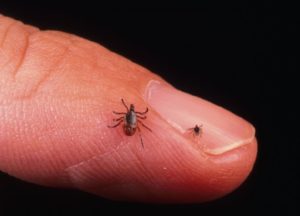Preparedness, Pragmatism Are Key

The larger wood tick doesn’t carry Lyme disease, while the tiny deer tick
can transmit Lyme and several other diseases to humans and dogs.
This has been banner year for ticks in the woods. The reasons are complicated and not always quantifiable. Along with high humidity and wet conditions, a less intuitive factor was a bumper crop of acorns in 2015, which produced a booming population of the deer tick host, the white-footed mouse. Ironically, the mice do not become infected themselves with tick-borne diseases.
The mice do provide the habitat where deer tick larvae develop into nymph forms and, later in the season, into adults. The nymph forms, which are the size of a pencil point, tend to bite and infect deer and humans with Lyme disease in the peak months of May, June and July. By fall, the adults – now apple-seed-sized organisms – continue to feed on the blood of humans and deer until the first hard frost. Throughout this May to October period, the deer ticks can transmit Lyme disease and other tick-borne illnesses.
The ticks can be found in sparse forests and in gardens, where they live under leaves and other debris. Ticks cannot jump or fly, instead crawling onto the feet or ankles of their victims. Barriers to their spread from surrounding brush include wood chips and gravel, which are difficult for them to crawl across.
Lyme disease, known since the 1970s, is familiar to many in New England as a disease that causes mild fever, headache and, sometimes, a red rash up to a week after the bite of a deer tick infected by the Lyme parasite. Without treatment, infection can eventually lead to arthritis and neurological problems. The tick has to be attached to the human for 36 to 48 hours; infection when the tick is in place for less than 24 hours is unlikely. Diagnosis is made by finding antibodies in the blood of the infected person, although the antibodies may not appear until two to four weeks after infection.
Other diseases carried by deer ticks include Anaplasmosis, Babesiosis , and Powassan virus infection. Anaplasmosis and Babesiosis became known in the early 2000s, and Powassan virus about 2013. While it may be alarming to think that new diseases carried by deer ticks are being identified, these diseases are fundamentally different from Lyme. They are easier to diagnose because they cause severe symptoms, so that the presence of disease is indisputable. They also do not cause long-term chronic illness, and they are very uncommon. Unlike Lyme disease, Anaplasmosis and Babesiosis can be diagnosed immediately by a peripheral blood smear that shows the organism inside the cell. Nationwide, in 2016, there were about 30,000 reported cases of Lyme disease, 1,800 cases of Babesiosis, 800 cases of Anaplasmosis, and seven cases of Powassan virus.
The effects of these other tick-borne diseases on the kidneys, blood clotting, liver and neurological function provide a secondary means of diagnosis by using other ancillary blood tests. Anaplasmosis , similar to Rocky Mountain spotted fever, and Babesiosis, a malaria-like illness, are very treatable with good outcomes. Powassan virus causes an encephalitis that shares the poor neurological prognosis of the Eastern Equine virus transmitted by mosquitoes.
Awareness and prevention are the keys to enjoying our time outdoors mindfully, but not fearfully. Applying the repellent DEET is helpful, with special attention to the shoes and ankles, with socks pulled up over your trousers. The tick you find on your shoulders or scalp has usually crawled up there from your feet. An alternative repellent, permethrin, which is toxic to the tick, can be applied to clothing, and permethrin-impregnated trousers and sleep sacks are available. Vinegar and natural oils like geranium, lavender, eucalyptus, and garlic may be helpful. It’s important to do a full body skin check when you come in from the meadows (where deer love the tall grass,) the woods OR the garden. Take a shower and put your dry clothes in the dryer for ten minutes.
A helpful video on the deer tick bite appearance, the rash, and instructions on removing ticks is available at the New York Department of Health website health.ny.gov/diseases/ communicable/lyme.
Since 2010, the Medical Zoology lab at UMASS Amherst has offered a test to the public of ticks for Lyme disease, Babesiosis, and Anaplasmosis for $50. (Call 413-545-1057 or go to tickreport.com.) Last year the lab tested 10,000 ticks. The larger wood tick doesn’t carry Lyme disease, while the tiny deer tick can transmit Lyme and several other diseases to humans and dogs.
Sixty percent of the deer ticks tested did not carry Lyme disease. It’s important to note that a positive test does not definitively demonstrate that the disease has been transmitted to the person who was bitten.
In New England, it is important to remember that the 100% larger wood or so-called dog ticks do not carry Lyme disease. Also, Lyme disease continues to be a problem in areas where deer have been eradicated, as mice are the primary vectors. Pet owners have not been shown to have more tick-borne illnesses than others.
You can stay informed by following the literature and up-to-date epidemiological data from the Centers for Disease Control at cdc.gov/Lyme. In addition, citizen scientists can contribute to ongoing research that works to expand the limited knowledge on changing tick populations by visiting the University of Rhode Island Tick Encounter Resource Center and reporting their tick encounters.
With some pragmatic precautions, we can continue to enjoy the many benefits that we and our families derive from our time off the beaten path and in the woods.
Brigid Glackin
Originally published in the Fall 2017 BBC Newsletter.
